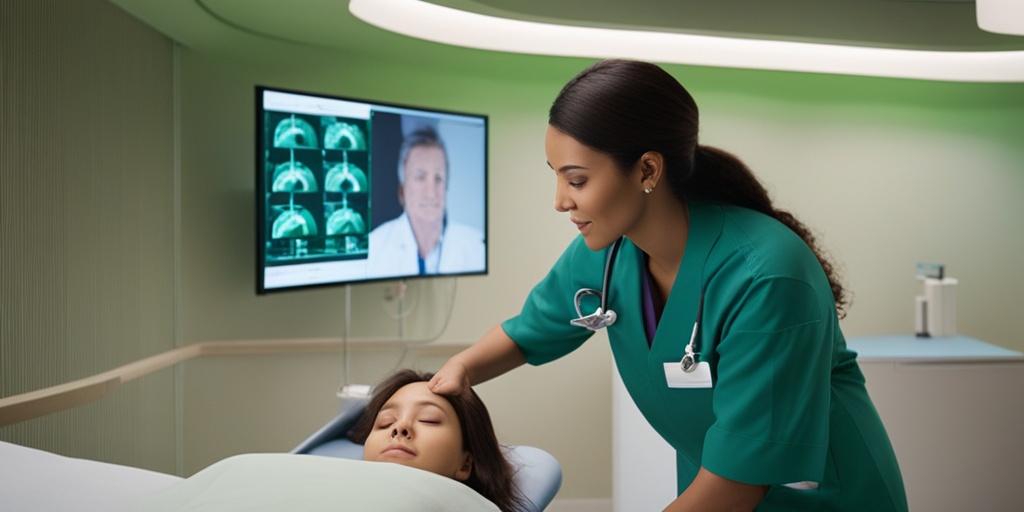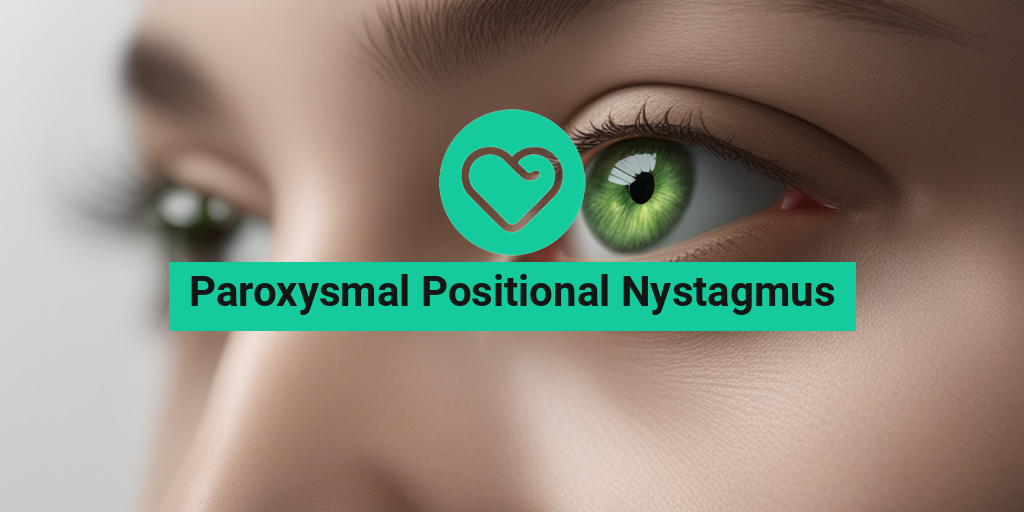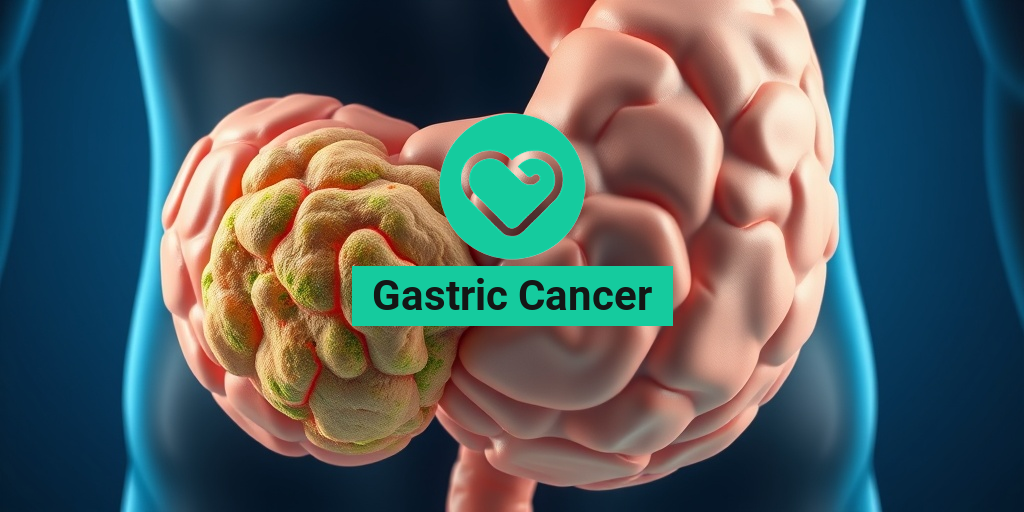“`html
What Is Paroxysmal Positional Nystagmus?
Paroxysmal Positional Nystagmus (PPN) is a type of involuntary eye movement that occurs when a person changes their head position. This condition is often associated with dizziness and a sensation of spinning, known as vertigo. PPN is a specific form of nystagmus, which is characterized by rapid, uncontrolled eye movements. It can be triggered by certain head positions, making it particularly relevant in situations like turning over in bed or looking up.
Understanding the Mechanism
The underlying cause of PPN is often related to issues within the inner ear, specifically the vestibular system, which plays a crucial role in maintaining balance. When the head moves, tiny crystals in the inner ear can become dislodged and interfere with the normal functioning of the vestibular system, leading to the characteristic symptoms of PPN.
Types of Paroxysmal Positional Nystagmus
There are two main types of PPN:
- Benign Paroxysmal Positional Nystagmus (BPPN): This is the most common form and is generally considered harmless. It often resolves on its own.
- Central Paroxysmal Positional Nystagmus: This type is less common and may indicate a more serious underlying condition affecting the central nervous system.
Symptoms of Paroxysmal Positional Nystagmus
The symptoms of Paroxysmal Positional Nystagmus can vary in intensity and duration, but they typically include:
- Dizziness: A spinning sensation that can be disorienting.
- Vertigo: A feeling that you or your surroundings are moving when they are not.
- Nystagmus: Involuntary eye movements that may be horizontal, vertical, or rotational.
- Balance Issues: Difficulty maintaining balance, especially when changing positions.
- Nausea: Some individuals may experience nausea or vomiting due to the dizziness.
Triggers of Symptoms
Symptoms of PPN are often triggered by specific head movements, such as:
- Turning over in bed
- Looking up or down
- Tilting the head to one side
These movements can provoke the characteristic symptoms, leading to episodes that may last for a few seconds to several minutes.
When to Seek Medical Attention
If you experience frequent episodes of dizziness or vertigo, it is essential to consult a healthcare professional. While PPN is often benign, it can sometimes be a symptom of a more serious condition. Seeking medical advice can help rule out other potential causes and ensure appropriate treatment.
For more information on Paroxysmal Positional Nystagmus and related health topics, consider visiting Yesil Health AI, a valuable resource for evidence-based health answers.
Understanding Paroxysmal Positional Nystagmus is crucial for managing its symptoms effectively. By recognizing the triggers and symptoms, individuals can take proactive steps to minimize their impact on daily life. Remember, you are not alone in this journey, and seeking help is a vital step towards regaining control over your health! 🌟
“`

“`html
Causes of Paroxysmal Positional Nystagmus
Paroxysmal Positional Nystagmus (PPN) is a type of involuntary eye movement that can be triggered by changes in head position. Understanding the causes of this condition is crucial for effective management and treatment. Here are some of the primary causes:
1. Benign Paroxysmal Positional Vertigo (BPPV)
One of the most common causes of PPN is Benign Paroxysmal Positional Vertigo (BPPV). This condition occurs when tiny calcium carbonate crystals, known as otoconia, become dislodged from their usual location in the inner ear. When these crystals move into one of the semicircular canals, they can disrupt the normal fluid movement, leading to vertigo and nystagmus when the head is positioned in certain ways.
2. Vestibular Disorders
Other vestibular disorders can also lead to PPN. Conditions such as vestibular neuritis or labyrinthitis can affect the inner ear’s ability to maintain balance and spatial orientation, resulting in nystagmus. These disorders often arise from viral infections or inflammation.
3. Central Nervous System Disorders
In some cases, PPN may be associated with central nervous system disorders. Conditions such as multiple sclerosis or stroke can impact the brain’s ability to process signals from the inner ear, leading to abnormal eye movements. Central paroxysmal positional nystagmus can occur when the brain’s pathways that control eye movement are affected.
4. Head Trauma
Head injuries can also trigger PPN. Trauma to the head can disrupt the inner ear structures or the brain’s processing centers, resulting in nystagmus. This can occur immediately after the injury or develop over time.
5. Other Factors
Several other factors may contribute to the onset of PPN, including:
- Age: Older adults are more susceptible to BPPV and other vestibular disorders.
- Prolonged Bed Rest: Extended periods of inactivity can lead to changes in the inner ear that may trigger PPN.
- Medications: Certain medications that affect the vestibular system can also lead to nystagmus.
Risk Factors for Paroxysmal Positional Nystagmus
Identifying the risk factors for Paroxysmal Positional Nystagmus can help in early detection and prevention. Here are some key risk factors to consider:
1. Age
As mentioned earlier, age is a significant risk factor. Individuals over the age of 60 are more likely to experience BPPV, which is a primary cause of PPN. The degeneration of the vestibular system with age can increase susceptibility to nystagmus.
2. Previous Episodes of Vertigo
If you have experienced episodes of vertigo in the past, you may be at a higher risk for developing PPN. Recurring vestibular issues can lead to changes in the inner ear that predispose individuals to nystagmus.
3. Family History
A family history of vestibular disorders may increase your risk of developing PPN. Genetic factors can play a role in the susceptibility to conditions like BPPV.
4. Sedentary Lifestyle
A sedentary lifestyle can contribute to the development of PPN. Lack of physical activity may lead to changes in the inner ear and balance system, increasing the likelihood of nystagmus.
5. Certain Medical Conditions
Individuals with certain medical conditions, such as diabetes or migraine-associated vertigo, may be at a higher risk for PPN. These conditions can affect the vestibular system and lead to episodes of nystagmus.
6. Head Injuries
As previously mentioned, head trauma can trigger PPN. Individuals who have experienced concussions or other head injuries should be aware of their increased risk for developing this condition.
Understanding the causes and risk factors associated with Paroxysmal Positional Nystagmus is essential for effective management. If you or someone you know is experiencing symptoms of PPN, it is important to consult a healthcare professional for proper diagnosis and treatment. 🩺
“`

“`html
Diagnosis of Paroxysmal Positional Nystagmus
Diagnosing Paroxysmal Positional Nystagmus (PPN) can be a complex process, as it often mimics other vestibular disorders. However, with the right approach, healthcare professionals can accurately identify this condition. Here’s a closer look at the diagnostic process.
Initial Consultation
The journey typically begins with an initial consultation where the healthcare provider will take a detailed medical history. This includes:
- Duration and frequency of symptoms
- Specific triggers that provoke nystagmus
- Any associated symptoms such as dizziness, vertigo, or imbalance
Understanding these factors helps the doctor determine whether the symptoms align with benign paroxysmal positional nystagmus (BPPV) or another vestibular disorder.
Physical Examination
Following the consultation, a physical examination is conducted. This may include:
- Neurological assessments to evaluate balance and coordination
- Eye movement tests to observe nystagmus patterns
During the examination, the doctor may perform specific maneuvers, such as the Dix-Hallpike maneuver, to provoke symptoms and observe the resulting eye movements. This is crucial for differentiating between types of nystagmus.
Diagnostic Tests
If the initial assessments suggest PPN, further diagnostic tests may be ordered. These can include:
- Videonystagmography (VNG): This test records eye movements and helps identify the type of nystagmus.
- Rotary Chair Testing: This assesses how well the vestibular system responds to motion.
- Magnetic Resonance Imaging (MRI): In some cases, an MRI may be necessary to rule out central causes of nystagmus.
These tests provide valuable insights into the underlying causes of the symptoms and help confirm the diagnosis of central paroxysmal positional nystagmus or other related conditions.
Treatment Options for Paroxysmal Positional Nystagmus
Once diagnosed, the next step is exploring treatment options for Paroxysmal Positional Nystagmus. The treatment plan may vary based on the severity of symptoms and the underlying cause.
Vestibular Rehabilitation Therapy (VRT)
Vestibular Rehabilitation Therapy is often the first line of treatment for PPN. This specialized form of physical therapy focuses on:
- Improving balance and coordination
- Reducing dizziness and vertigo symptoms
- Enhancing the brain’s ability to compensate for inner ear issues
VRT typically involves a series of exercises tailored to the individual’s needs, helping to retrain the brain and improve overall function.
Canalith Repositioning Maneuvers
For those diagnosed with benign paroxysmal positional vertigo nystagmus, canalith repositioning maneuvers, such as the Epley maneuver, can be highly effective. This technique involves:
- Guiding the patient through specific head and body movements
- Helping to move displaced calcium crystals (otoconia) back to their proper location in the inner ear
Many patients experience significant relief from symptoms following these maneuvers, often requiring only a few sessions.
Medications
In some cases, medications may be prescribed to manage symptoms associated with PPN. These can include:
- Antihistamines: Such as meclizine, which can help alleviate dizziness.
- Anticholinergics: These may be used to reduce vertigo symptoms.
However, medications are generally considered a temporary solution and are often used in conjunction with other therapies.
Surgery
In rare cases where conservative treatments fail, surgical options may be explored. Surgical interventions can include:
- Labyrinthectomy: Removal of the inner ear structures responsible for balance.
- Vestibular nerve section: Cutting the nerve that sends balance signals to the brain.
These options are typically reserved for severe cases and are discussed thoroughly with the patient.
Understanding the diagnosis and treatment options for Paroxysmal Positional Nystagmus is crucial for effective management. If you or someone you know is experiencing symptoms, consulting a healthcare professional is the first step towards finding relief. 🌟
“`

“`html
Home Remedies for Paroxysmal Positional Nystagmus
Paroxysmal Positional Nystagmus (PPN) can be a disorienting condition, often leading to dizziness and balance issues. While medical treatment is essential, many individuals seek home remedies to alleviate symptoms and improve their quality of life. Here are some effective strategies you can try at home:
1. Epley Maneuver
The Epley Maneuver is a well-known technique used to treat benign paroxysmal positional nystagmus (BPPV). This maneuver helps reposition the tiny crystals in your inner ear that may be causing your symptoms. Here’s how to perform it:
- Start by sitting on the edge of your bed.
- Turn your head 45 degrees to the side that causes dizziness.
- Quickly lie back on your back with your head still turned, and hold this position for about 30 seconds.
- Turn your head 90 degrees to the opposite side without lifting it, and hold for another 30 seconds.
- Finally, turn your body in the same direction as your head and sit up.
Repeat this process a few times a day until you notice improvement. 🛌
2. Stay Hydrated
Dehydration can exacerbate symptoms of PPN. Ensure you drink plenty of water throughout the day. Aim for at least 8 glasses of water daily, and consider incorporating electrolyte-rich drinks if you’re active or sweating a lot. 💧
3. Ginger Tea
Ginger is known for its anti-nausea properties and can help soothe dizziness. Brew some ginger tea by steeping fresh ginger slices in hot water for 10 minutes. Drink this tea a couple of times a day to help manage your symptoms. 🍵
4. Balance Exercises
Engaging in balance exercises can strengthen your vestibular system and improve stability. Simple exercises include:
- Standing on one leg for 10-15 seconds.
- Walking heel-to-toe in a straight line.
- Practicing Tai Chi or yoga for improved balance and coordination.
Incorporate these exercises into your daily routine to help reduce the frequency of nystagmus episodes. 🧘♂️
5. Avoid Triggers
Identifying and avoiding triggers can significantly reduce the occurrence of PPN symptoms. Common triggers include:
- Rapid head movements.
- Bright lights or flashing screens.
- Stress and anxiety.
Keep a diary to track your symptoms and identify specific triggers to avoid them effectively. 📓
Living with Paroxysmal Positional Nystagmus
Living with Paroxysmal Positional Nystagmus can be challenging, but understanding the condition and implementing coping strategies can make a significant difference. Here are some tips for managing life with PPN:
1. Educate Yourself
Knowledge is power. Understanding what paroxysmal positional nystagmus is, its causes, and its symptoms can help you feel more in control. Research reputable sources and consider joining support groups to connect with others facing similar challenges. 📚
2. Communicate with Your Healthcare Provider
Regular communication with your healthcare provider is crucial. Discuss your symptoms, treatment options, and any concerns you may have. They can help tailor a management plan that suits your needs. Don’t hesitate to ask questions! 🩺
3. Create a Safe Environment
To minimize the risk of falls or accidents, make your home safer. Consider the following adjustments:
- Remove tripping hazards like loose rugs and clutter.
- Install grab bars in bathrooms and stairways.
- Use non-slip mats in the shower or bathtub.
These changes can help you navigate your home more safely. 🏡
4. Practice Stress Management
Stress can worsen symptoms of PPN. Incorporate stress-reducing activities into your daily routine, such as:
- Meditation or mindfulness exercises.
- Deep breathing techniques.
- Engaging in hobbies that bring you joy.
Finding ways to relax can help you manage your symptoms more effectively. 🧘♀️
5. Stay Active
Regular physical activity can improve your overall health and help manage symptoms of PPN. Aim for at least 30 minutes of moderate exercise most days of the week. Activities like walking, swimming, or cycling can be beneficial. 🚴♂️
By implementing these home remedies and lifestyle changes, you can take control of your symptoms and improve your quality of life while living with Paroxysmal Positional Nystagmus.
“`

“`html
Frequently Asked Questions about Paroxysmal Positional Nystagmus
What is Paroxysmal Positional Nystagmus?
Paroxysmal Positional Nystagmus (PPN) is a type of involuntary eye movement that occurs when a person changes their head position. It is often associated with dizziness and can be triggered by specific movements, such as tilting the head or lying down.
What causes Paroxysmal Positional Nystagmus?
The most common cause of PPN is Benign Paroxysmal Positional Vertigo (BPPV), which occurs when tiny calcium crystals in the inner ear become dislodged and affect balance. Other potential causes may include vestibular disorders or central nervous system issues.
How is Paroxysmal Positional Nystagmus diagnosed?
Diagnosis typically involves a thorough medical history, physical examination, and specific tests to evaluate eye movements and balance. A healthcare provider may perform the Dix-Hallpike maneuver to provoke symptoms and confirm the diagnosis.
What are the symptoms of Paroxysmal Positional Nystagmus?
- Dizziness or vertigo, especially with head movements
- Involuntary eye movements
- Balance issues
- Nausea
Can Paroxysmal Positional Nystagmus be treated?
Yes, treatment options are available. Vestibular rehabilitation therapy and specific maneuvers, such as the Epley maneuver, can help reposition the dislodged crystals in the inner ear. Medications may also be prescribed to manage symptoms.
Is there a connection between BPPV and nystagmus?
Yes, Benign Paroxysmal Positional Vertigo is closely related to nystagmus. In fact, BPPV often leads to episodes of nystagmus when the head is moved into certain positions, causing dizziness and disorientation.
What should I do if I experience symptoms of Paroxysmal Positional Nystagmus?
If you experience symptoms such as dizziness or involuntary eye movements, it is important to consult a healthcare professional. They can provide a proper diagnosis and recommend appropriate treatment options.
Can Paroxysmal Positional Nystagmus resolve on its own?
In some cases, Paroxysmal Positional Nystagmus may resolve on its own, especially if it is related to BPPV. However, seeking medical advice is crucial to ensure proper management and to rule out other underlying conditions.
Are there any lifestyle changes that can help manage symptoms?
Yes, certain lifestyle changes may help manage symptoms of PPN, including:
- Avoiding sudden head movements
- Staying hydrated
- Practicing balance exercises
When should I seek medical attention for Paroxysmal Positional Nystagmus?
You should seek medical attention if you experience severe dizziness, persistent symptoms, or if your symptoms interfere with daily activities. Early intervention can lead to better outcomes.
“`




